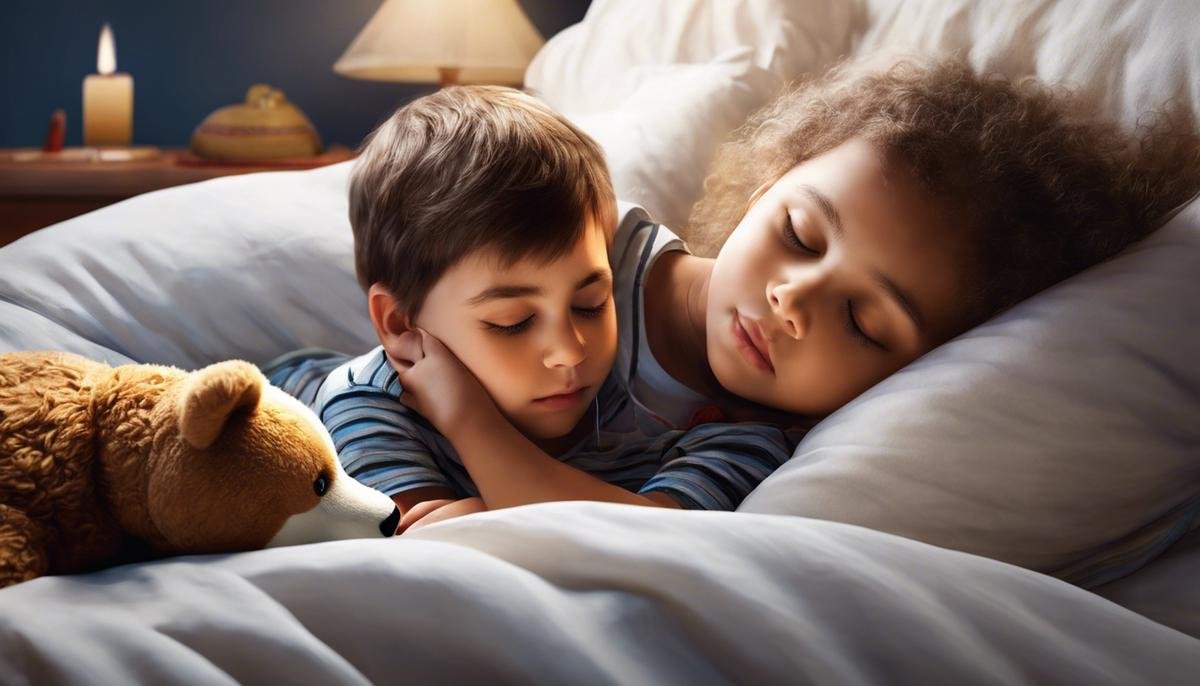
Embarking on a compassionate journey toward understanding the intricacies of neurodiversity, this essay shines a light on the lived experiences of families navigating the complexities of autism, Obsessive-Compulsive Disorder (OCD), and associated sleep challenges. We begin by diving into ‘Understanding Autism and Its Challenges,’ dissecting the unique characteristics that form the tapestry of autism spectrum disorder and the profound impact it can have on social interactions, sensory processing, and communication. As we turn the page to ‘OCD in the Family: Recognizing and Coping,’ we unveil the essence of OCD, the trials it presents in young lives, and the sanctuary that familial understanding and support can provide. The following section, ‘Sleep Issues and Neurodiversity,’ casts a much-needed spotlight on the nocturnal hurdles faced by those with autism and OCD and offers a beacon of hope through actionable advice for healthier sleep patterns. Continuing our expedition, ‘Parenting Strategies for Children with Autism and OCD,’ equips caregivers with insightful tools and empathetic perspectives crucial for nurturing their children’s growth and well-being. Finally, ‘Creating a Supportive and Inclusive Home Environment’ culminates our exploration by envisioning a space where acceptance and adaptability pave the way for a harmonious, inclusive family life.
Understanding Autism and Its Challenges
Embracing Unique Journeys: Understanding Autism’s Impact on Children and Families
Navigating the waters of family life is always a voyage of discovery, but when a child is on the autism spectrum, that journey can bring with it some unique waves to ride. Let’s dive into understanding how autism uniquely affects children and the families who love them, and maybe we’ll pick up some invaluable treasures along the way.
Autism is a spectrum disorder which means every child with autism has a one-of-a-kind set of characteristics that make them the unique little beings they are. Some might have an incredible memory for details, while others could possess a remarkable talent for music or art. However, what unites them all are some common challenges in social communication, sensory processing and flexibility in thought and behavior.
For children, these challenges can mean the world looks different to them. Imagine a playground not as a space for fun, but as an overwhelming maze of noise, movement, and confusing social cues. A child with autism might struggle to make friends, not because they don’t want to, but because the unwritten rules of social interaction are harder for them to understand and navigate.
Beyond their own experiences, autism deeply affects families too. Parents and siblings might find themselves tailoring daily routines to better suit their loved one on the spectrum. This could include creating a sensory-friendly home environment or learning new communication techniques. It’s like becoming fluent in a new language – the language of their child’s individual needs.
Family life can see a shift in focus, with much time dedicated to therapy appointments, educational planning and advocating for the child’s needs. This isn’t to say that life is solely about autism; families often find joy in celebrating the unique strengths and victories that come with it. Witnessing a child make a new friend or express their emotions can feel like a monumental success, worthy of the grandest celebration.
Let’s not forget siblings, who may ride a rollercoaster of their own emotions – pride in their brother’s or sister’s uniqueness, alongside the occasional frustration of feeling less attended to. The opportunity lies in guiding them to become empathetic, understanding individuals who can champion their sibling’s cause in the wider world.
Remember, no path walked with love, patience, and acceptance is ever wrong. The key to navigating this unique family journey? A blend of resilience, resourcefulness, and a whole lot of heart. The networks of support both online and offline are strong and vast, with countless families sharing in the same voyage. While each family’s map looks different, the destination remains clear – one of understanding, acceptance, and immeasurable love.
There is richness in the diversity of these experiences, and every challenge faced with grace strengthens not just the individual, but the family as a whole. Autism’s unique effect on children and families is as much a journey of growth and understanding as it is a shared human experience across the colorful spectrum of life. And in this community, every small step forward is a step worth celebrating together.

OCD in the Family: Recognizing and Coping
Recognizing and Supporting OCD in Our Children: A Family-Centered Approach
Hey, there, cherished parenting community,
Chances are, you’ve heard of obsessive-compulsive disorder (OCD), a condition that can impact individuals of all ages, including our precious youngsters. While we’ve navigated the complexities of autism together, it’s essential to shine a light on OCD, a condition often misunderstood and overlooked in children. Understanding these signs and offering unwavering support are crucial steps in nurturing a healthy, happy family dynamic.
So, what exactly does OCD look like in a child’s world? It’s a tapestry often woven with repetitive behaviors and fixated thoughts that they can’t easily control or push aside. You might notice a child incessantly washing hands, hyper-organizing toys until it feels “just right,” or getting stuck on a single thought. These are the red flags that may signal it’s time to delve deeper.
These symptoms can sometimes create ripples in the day-to-day flow of family life, much like autism can. Imagine morning routines stretching endlessly as a child feels compelled to perform a sequence of tasks repeatedly. Or picture the frustration when a family outing is disrupted by an overwhelming need to return home and check that the doors are locked — several times.
As loving parents and caregivers, our hearts stretch to accommodate these challenges while seeking ways to support our children wholeheartedly. Start by cultivating a home atmosphere that’s as stress-free as possible. Talk openly about these behaviors without judgement, letting your child know it’s okay and they’re not alone. Small, supportive conversations can alleviate the enormity of their internal struggles.
Partnering with mental health professionals who specialize in treating OCD is another step in building a framework of support. These experts can introduce cognitive-behavioral therapy (CBT), a proactive approach to help children manage their symptoms. It’s about equipping them with the tools to face OCD head-on and reclaim the freedom to just be kids.
Remember, while support systems range from school counselors to local support groups, the cornerstone of any child’s support network is family. Siblings can play a supportive role, too, by understanding their brother or sister’s unique circumstances and rallying together as unbreakable teams against OCD’s challenges.
Embrace every victory over OCD, whether it’s resisting a compulsion or trying out a new coping strategy. And when setbacks happen, as they sometimes will, it’s just another chance to stand together and say, “We’ve got this!”
Striving for a life more focused on joy than on rituals or worries is a journey. It takes endless love, monumental patience, and a community of hearts and hands. And remember, no two families’ journeys are the same — but the common thread that binds us all together is the unwavering belief in our children’s strength and potential.
Together, let’s continue to weave a tapestry of understanding, support, and tireless advocacy for our children, whether they’re dancing to the unique tune of autism or marching to the meticulous rhythm of OCD. Because in the end, every step forward is a shared triumph, and every helping hand extended strengthens the bonds of our beautiful, resilient community.

Sleep Issues and Neurodiversity
Tackling Sleep Struggles for Children with Autism and OCD
As many families know all too well, sleep can be a tricky business for children, especially those with autism and OCD. It’s not just about monsters under the bed or needing one more glass of water — the hurdles are higher and the nights can be longer. Understanding the roots of these sleep issues and finding effective strategies is key to ensuring that these little ones (and let’s be honest, their caregivers too) get the restful shut-eye they need.
Now, let’s shed some light on those nighttime challenges. Children with autism may have difficulty winding down due to heightened sensitivity to their environments. The hum of an air conditioner that most wouldn’t notice can sound like a marching band to a sensitive child. In addition to this, the natural production of melatonin, the sleep hormone, might be lower or irregular in some kids on the spectrum, throwing a monkey wrench into their sleep patterns.
Similarly, children with OCD can find themselves caught in the snare of repetitive thoughts and behaviors that don’t clock out when it’s bedtime. The urge to perform rituals can surge at night, making the process of simply getting into bed and closing their eyes a drawn-out affair. Anxiety, a close companion of OCD, also loves to throw sleep parties, unwanted and untimely as they may be.
What’s a family to do? Creating a bedtime oasis is where it all starts. Imagine a room that’s as calming to the senses as a lullaby. This might mean investing in blackout curtains or using soothing colors for bedding and pajamas. White noise machines can be lifesavers, or for those melody-lovers, consider soft, calming music.
Routine is the best friend of a good night’s sleep. Establishing a predictable bedtime process can be a game changer. This ritual can include a warm bath, reading a favorite book, or some gentle stretching or breathing exercises. It’s all about signaling to those busy brains that it’s time for rest, not play.
Sometimes, nature needs a bit of a nudge, and this is where supplements like melatonin come in, after a thumbs-up from a healthcare provider, of course. Keep in mind that less is often more when it comes to dosing and that the goal is to support, not override, the natural sleep processes.
For those routine rituals of children with OCD, cognitive-behavioral strategies, learned hand in hand with a skilled therapist, can turn the tide. These include exposure therapy, where a child gradually faces their bedtime fears, or the practice of delaying the compulsion, giving them empowerment over the situation. Mindfulness techniques can also be a comforting blanket, teaching children to settle their minds.
Good sleep hygiene involves the entire family. Ensuring that screens are turned off well before bedtime, keeping caffeine away from the dinner table, and making sure the household becomes a quieter, more tranquil space as night falls are all part of the equation.
Let’s not forget that tackling these challenges is just as much about celebrating every successful night as learning from the difficult ones. Whether it’s a sticker chart to reward a peaceful bedtime or simply acknowledging their bravery in facing their nighttime fears, positive reinforcement goes a long way.
The journey toward conquering sleep issues in children with autism and OCD is a marathon, not a sprint. Patience truly is a virtue, and the smallest improvements can be huge triumphs. With tender compassion, a dash of creativity, and perhaps a sprinkle of fairy dust (or melatonin), the land of dreams can become a welcome retreat for these special children and their families. Here’s to more zzz’s and fewer, well, please-not-tonights. Sleep tight, families!

Parenting Strategies for Children with Autism and OCD
Parenting children with complex needs, including those with autism and obsessive-compulsive disorder (OCD), requires a toolbox filled with effective techniques, boundless love, and an ocean of patience. Part of the journey involves understanding and managing the intricate dance of emotions and behaviors that both conditions involve. While the first half of the article has already established an excellent foundation, there are yet additional aspects to delve into that can further support the well-being and growth of children with these challenges.
Strategizing for Success: Structure and Visual Support
One aspect that can’t be understated is the power of structure. Children with autism often thrive under predictable routines that help them navigate the ambiguity of the daily grind. Visual schedules and charts can be lifesavers. They provide clear expectations and a sense of control, easing the anxiety that often accompanies the unknown. For kiddos with OCD, routine creates a haven of stability amidst the turmoil of intrusive thoughts and compulsions.
Embracing Technology: Apps and Assistive Devices
In this digital age, technology is a boon for children with special needs. There’s a multitude of apps designed to improve communication, social skills, and even help manage OCD symptoms. Look for ones that gamify learning and practice of life skills or encourage relaxation and mindfulness, which can be particularly helpful in managing the stress and anxiety linked to both autism and OCD.
Consistency is Key: Unified Parenting Approaches
When managing behaviors, consistency across all caregivers is crucial. Whether it’s setting limits or responding to a child’s requests, keeping a united front helps children understand boundaries and expectations, reducing anxiety by removing mixed messages.
Educational Advocacy: Finding the Right Learning Environment
One size certainly does not fit all when it comes to education for children with autism and OCD. It’s paramount to be an advocate for finding or creating learning environments that accommodate individual needs. Whether it’s an IEP (Individualized Education Program) in public schools or finding a private institution that specializes in teaching neurodiverse students, the goal is to ensure a supportive educational journey.
Therapy Integration: From Speech to Occupational Therapy
Often overlooked is the integration of various therapies. Speech therapy can help with communication barriers, while occupational therapy can assist with daily living skills and sensory sensitivities. It’s vital, though, to ensure that all involved therapists are in sync and working towards common goals.
Self-Care for the Caregiver: The Oxygen Mask Principle
Finally, caring for a caregiver themself is instrumental. It’s the classic ‘oxygen mask’ principle – one can’t assist others without ensuring they are breathing well themselves. Practicing self-care, seeking respite services, or joining a support group are all ways to recharge those batteries.
Each day brings its own set of challenges, but amidst the trials, there are triumphs. Perhaps it’s a word spoken for the first time, a successfully averted meltdown, or a night where the shadows of OCD don’t seem so dark. These moments shine brightly, fueling the journey forward and reminding us all of the remarkable resilience and potential within each child. Keep celebrating, keep advocating, and keep loving – it’s through these that the extraordinary is often achieved.

Creating a Supportive and Inclusive Home Environment
Creating a Nurturing Home for Children with Autism and OCD: Embracing Flexibility and the Joy of Accomplishment
In homes where there is a blend of love, consistency, and a pinch of creativity, children with special needs find their sanctuary. Parents and family members who have embraced the journey of nurturing a child with autism or Obsessive-Compulsive Disorder (OCD) understand the importance of a supportive home environment. Although structures and routines are essential, a key ingredient is often overlooked: the beauty of flexibility.
Flexibility isn’t about abandoning routines; it’s about adapting them. When children with autism or OCD face a world that can feel unpredictable, knowing their home is a place where routines can bend—never break—to accommodate their needs is reassuring. Parents are the architects of this gentle flexibility, which is often designed in the moments.
Imagine a visual schedule that a child with autism leans on daily. It’s a masterpiece of predictability until, one morning, the child expresses a desire to try something new. This is where embracing the opportunity to nourish their growth comes into play—adjust the schedule, applaud their initiative, and celebrate their willingness to explore. The same goes for a child with OCD who may need extra time to complete a task; understand that their pace is their progress.
In the digital age, technology has lent a helping hand. Apps and assistive devices tailor support to children’s unique abilities, ensuring they have the right tools to engage and grow. They assist in communication, education, and even play, leveling the playing field and allowing children with autism and OCD to shine in their way.
Consistency remains a cornerstone in managing behaviors, but applying consistency doesn’t mean rigidity. It’s about predictable responses, not predictable days. By offering a stable foundation, children feel safe to test their wings within the comfort of their nest.
Finding the right educational setting is an advocacy marathon that pays off exponentially for children with special needs. Whether it’s championing an Individualized Education Program (IEP) that meets a child’s specific needs or seeking out schools with inclusive policies, the right environment can transform learning from a challenge into an adventure.
Children with autism and OCD often benefit from a multidisciplinary approach to therapy. Speech, occupational, and even art therapies all contribute to children’s abilities to navigate their worlds with confidence. It’s not about changing who they are; it’s about giving them the skills to showcase their incredible potential.
And to the unsung heroes, the caregivers: self-care is not selfish. It’s fundamental. Running on empty serves no one, least of all the children who need you most. Seek support, lean on respite services, and join communities that uplift. In taking care of oneself, the capacity to care for others is refilled.
Amidst managing therapies, educational plans, and daily life, every little triumph deserves its own parade. A new word, a night without disruptions, a day where compulsions take a backseat—these milestones are the high fives, the hugs, and the “we got this” moments. They are proof of the resilience of children with complex needs and the boundless potential they possess.
In the dance of structure and spontaneity, the song that plays in homes accommodating children with autism and OCD is one of unwavering support, remarkable resilience, and the sweet sound of joy found in every victory, no matter how small.

The tapestry of familial life inhabiting the realms of autism, OCD, and sleep irregularities is rich with challenges, yet it is also imbued with the potential for profound growth, transformation, and unconditional love. By acknowledging and addressing the various facets of neurodiversity—including recognizing individual needs, advocating for tailored support, and fostering an environment ripe for inclusivity—we imbue our homes with strength and understanding. Such efforts, though often daunting, are instrumental in sculpting a world where every member, regardless of neurological makeup, can thrive. It’s not merely about crafting an accommodating living space or mastering therapeutic strategies; it’s about nurturing a culture of empathy and resilience. As we steadily weave the threads of knowledge, empathy, and unwavering support, we create a sanctuary where our loved ones can unfold the full breadth of their potential, and the family unit can celebrate every triumph, small and grand, along the spectrum of life’s rich tapestry.




